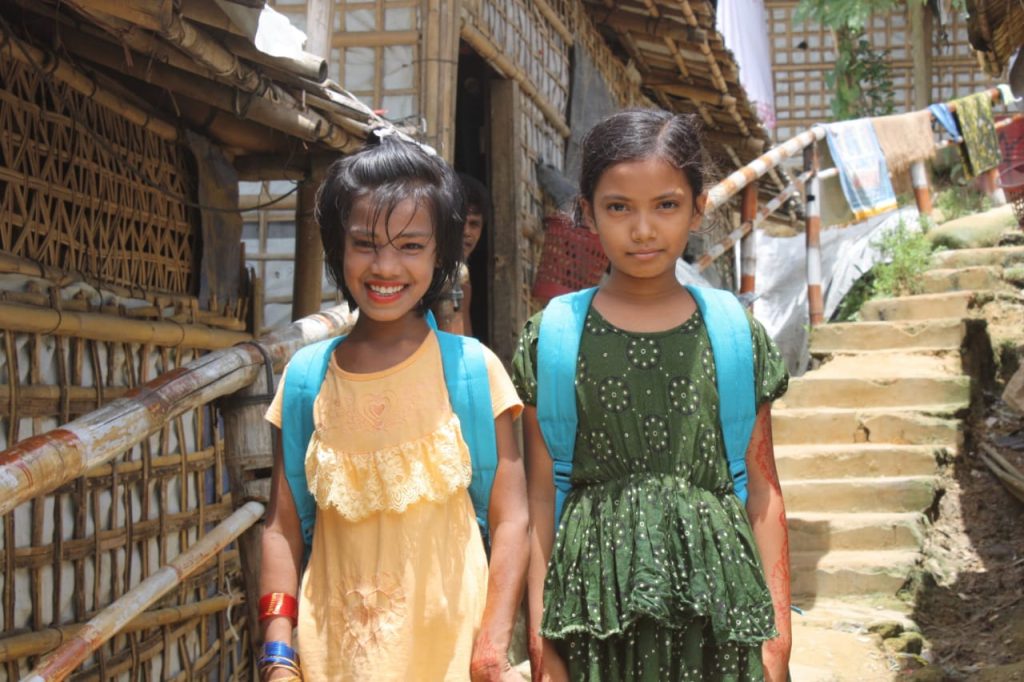By Author: Jeba Tasnia Ruhi, /Co – Author: Maung Thein Myint aka Moshor Rof (Bangladesh)
Introduction to Education System in Rohingya Refugee Camp
More than one million Rohingya Community from Myanmar have fled to Bangladesh as refugees over the last 40 years. Currently, over 950,000 Rohingya are living in 32 makeshift settlements camp around Cox’s Bazar in southern Bangladesh since 2017. The education system within the Rohingya refugee camps in Bangladesh response a unique set of challenges and the education has faced numerous difficulties and transformations. Among the Rohingya refugee community around 50% were children. The majority of these refugee children don’t have the proper access to educational opportunities. However, a number of International Non-governmental organizations (INGOs) and Non-governmental organizations (NGOs) in Bangladesh were offering difference kinds of educational opportunities to the Rohingya refugee children in both registered camps and makeshift settlements. The education system in these camps is characterized by its way on a mix of formal and informal educational structures such as both basic literacy and numeracy skills, as well as psychosocial support to help the children and young adults in these camps to build a foundation for their future and cope with the trauma they have experienced with limited resources and access.
The main objective of this study is to analyze these education policies and practices as well as explore the limitations of Education for Rohingya refugee children during this time of great transition and flux. The situation in the camps for the Rohingya refugees was precarious due to overcrowding, traumatize, disease, lack of suitable shelter and prevailing weather conditions, and facilitating education in these circumstances is particularly challenging. However, the education system in these camps faces ongoing challenges, such as inadequate teacher training, language barriers, and the need for more stability to improve the systems and educational resources. Addressing these issues is crucial for improving the quality of education and ensuring that the refugee children have a chance to rebuild their lives and integrate into a more stable and productive future and reveals that despite some challenges, Education is assisting in addressing psycho-social issues for Rohingya refugee children in Bangladesh.
Generalization of Education System in Rohingya Refugee Camp
Since 2018, the education program were implementing in the Rohingya Refugee camps into various aspects by difference kinds of NGOs and INGOs. The education system in Rohingya refugee camps has been focused on providing basic education and addressing the needs of displaced children. The United Nations and various non-governmental organizations (NGOs) have played the roles in this effort. They have set up temporary learning centers and schools within the camps to offer education in a range of subjects. Education initiatives in the camps are mainly driven by NGOs and UN agencies, including UNICEF, focusing on non-formal education for Rohingya children. The key programs are Learning Centers (LCs) and Accelerated Learning Approach (ALP) providing basic literacy, numeracy, and life skills. Initially, the education programs in the camp used a combination of informal education and an adapted Learning Competency Framework and Approach (LCFA), focusing on basic literacy, numeracy, and life skills. However, it was not specific to the Rohingya culture or aligned with their educational background as it was based on Guidelines for Informal Education Programme (GIEP).
In this curriculum, there were many kinds of challenges have to face by the implementing organization such as being fail to accommodate of children learning grade within their age category, there are specific challenges related to the children’s psychological aspects as all the children were experienced lots of traumatic moments while they are fleeing and some significant issues arise relevant to the LCFA Curriculum because it was developed fully new versions of curriculum for all the Rohingya Teachers and students and unqualified teachers being recruited who are not trained on the curriculum properly. The organizations often fail to supply the necessary resources such as textbooks and practical materials, etc.. Besides, the classrooms are often overcrowded and under-resourced, with limited materials such as books and supplies. Class sizes vary, but typically, there are around 30-40 students in each class, often crammed into small spaces and students sit closely together on mats or benches. Basically, there are 2 shifts in Learning Center and each shift has allocated 3 hours with a specific class routine. The LCFA curriculum were based 4 standards Competency as Level (1), Level (2), Level (3) and Level (4) according to age of children.
Due to the unfortunate condition of Camps, the disaster like Flooding, fire, landslide, heavy rainfall and civil conflicts played an intensive trauma to the children, destroy infrastructures, significantly disrupts education by displacing students, teachers and divert the educational resources . Sometimes, these include the closure of Learning Centers, losses of educational materials, lack of access to learning environment can led to metal health of the students and teachers. In this dire moment, the teacher used psychosocial support techniques such as play-based learning, art competition, and storytelling to help children express their emotions and cope with trauma. Creating a safe and supportive environment where children feel cared for is essential, Individuals work, Group activities that promote teamwork and interaction to overcome the mental health challenge. Despite the challenges, students are eager to learn, and there is a strong sense of community.
After three and half years later, the Myanmar National New Curriculum has been introduced for Rohingya children to prepare them for future reintegration into Myanmar and gradually transitioned from the Learning Competency Framework Approach (LCFA) and Accelerated Learning Approach (ALP) to the Myanmar National New Curriculum in 2021 is a tremendous demand for education among Rohingya refugee children throughout the Myanmar Curriculum Pilot (MCP), launched by UNICEF and its partners, is a critical step forward towards ensuring the fundamental right to education for Rohingya refugee children. It will help prepare the children for their return to Myanmar. The transformation involved introducing the grading systems as in Myanmar, but adapted to the local context in the camps. There have some specific challenges still including a lack of trained teachers familiar with the Myanmar National Curriculum, limited teaching resources, and logistical difficulties in distributing materials.
Additionally, cultural differences, language barriers made it hard to implement a rigid curriculum. Many teachers also required extensive training to effectively teach this curriculum and there are still significant gaps such as insufficient access to education for older children and adolescents, cultural barriers, and a lack of resources especially for trauma support. On the other hand, Enrollment of adolescent girls in Learning Centers remains a challenge with Cultural norms, safety concerns, and early marriage often prevent girls from attending. However, there are ongoing efforts to increase girls’ enrollment but the implementation do not fully address the diverse needs of the Rohingya community yet today. Furthermore, ongoing conflict and disaster can create insecure conditions; further impede consistent attendance and delivery quality education. As a result, educational progress in these camps is often delayed or halted, limiting opportunities for children to learn and develop.
From the earlier 2023, All the Learning Centers were operated by Myanmar National New Curriculum from KG to Grade 10 in the Rohingya Camps. With this curriculum, the Rohingya Community are somehow satisfied than earlier LCFA curriculum and they are curious to enroll their children in the camps and children are ongoing enrolling in the Learning Center. The curriculum grading system in the camp as follow;
SL | Types of Grading System | Grade Included | Preferred Subject | Remarks |
(I) |
Lower Primary Grades | ECD (Early Childhood Development), KG, Grade (1) and Grade (2) | ECD and KG are based on Co-Curriculum Activities without any specific Subject. In Grade (1) & Grade – 2, There have (6) Subjects such as Myanmar Language, English, Mathematics, Science, Social Study and Life Skill | |
(II) | Upper Primary Grades | Grade (3) , Grade (4) and Grade (5) | (In Grade (3, 4, 5), There have (6) Subjects such as Myanmar Language, English, Mathematics, Science, Social Study and Life Skill) | |
(III) | Lower Secondary Grades | Grade(6) ,Grade (7), Grade (8) and Grade (9) | (In Grade (6, 7, 8, 9), There have (6) Subjects such as Myanmar Language, English, Mathematics, Science, Geography and History) | |
(IV) | Higher Secondary Grades | Grade (10) and Grade (11) | (In Grade 10 and 11), There have many Subjects like Major Subjects and Minor Subjects in 2 Steams) Major Subjects are; Myanmar Language, English and Mathematics. Minor Subjects are based on Steam. |
In conclusion
Simultaneously, there are lots of initiatives taken to drive the education in Rohingya Refugee Camp since earlier to yet but still the implementation system should add more interventions to ensure the Quality Education Services in the Camps. The Rohingya Community is very essential to get access of involving and collaborating with the education sector so that community members especially educator of Rohingya Community can play a vital role by raising awareness about the importance of education and girls’ education, addressing cultural barriers, advocating for safe learning environments, and participating in planning processes, promoting the curriculum effectively, teacher training, community engagement, and better infrastructure are also key. It is essential to ensure that it is culturally relevant, trauma-informed, and adaptable to the camp’s unique needs by providing sufficient learning materials and psychosocial support within the curriculum with NGOs and local authorities. Also, including women in decision-making roles could also be beneficial and it is critical for its success. So that, the education sectors is requested and suggested to increase investment of teachers’ training effectively, improving educational and learning materials to enhance the quality of education, Recruiting Subject based teachers with qualified status, Providing Proper Psychological supports, establishing a fruitful class routine to ensure specialized instruction by adapting the curriculum relevant to Rohingya Community. Additionally, efforts should have to incorporate psychosocial support into the education system to help children cope with trauma and stress. The education system in these camps is should have continually evolving to improve access to higher study, quality, and sustainability in response to the ongoing diverse needs of the Rohingya Community.
Noted – This study is authentically carry out by interviewing with Rohingyas Teachers and Master Trainers who are currently engaging to Learning Center of Education Sector in Rohingya Refugee



